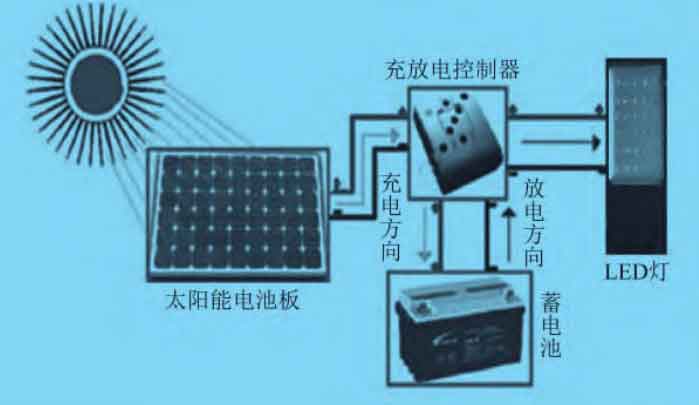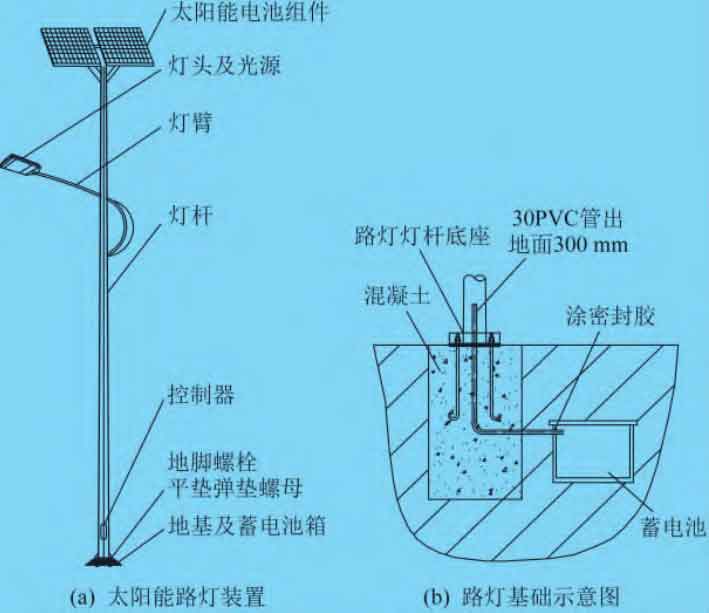The solar street lamp device is a road lighting device that uses solar photovoltaic power generation and power supply. Due to the characteristics of solar photovoltaic power generation, which generates electricity during the day and supplies power to street lamps at night, as well as the instability of solar energy resources caused by adverse factors such as rainy days, it is necessary to set up batteries to ensure the reliability of power supply for street lamps.This article analyzes various problems encountered in road lighting design for projects using high-power solar street lamp devices.It proposes some design principles for using high-power solar street lamp devices for lighting, providing a reference for future design of solar street lamp devices for lighting.
1. System configuration calculation
The main difference between the calculation of the solar streetlight device lighting system and the traditional road lighting calculation is the power supply scheme. Other aspects that require calculation and design are the same, including the selection of light sources, the arrangement of street lights, the installation height of lamps, the road surface illuminance, the road surface brightness, the maximum initial value of the glare limit threshold increment, the minimum value of the environmental ratio, and the calculation of the lighting power density.The traditional road lighting power supply method uses a box-type substation to supply power, while the solar streetlight device lighting uses solar power generation to supply power to the street lights.The schematic diagram of the solar streetlight system is shown in Figure 1.

This article only calculates and analyzes the solar photovoltaic power generation system of the solar street lamp device.Referring to the given calculation formula, firstly, the peak sunshine time is calculated based on the total irradiation of the inclined plane measured by local meteorological data. Then, combined with the known load power and light source working time, the solar panel capacity required for the normal operation of the load under the local solar irradiation conditions is calculated. Secondly, combined with the load power, load daily working time, storage days, discharge depth, and system voltage, the required battery capacity is calculated.Among them, the storage days consider the insufficient solar panel power generation on rainy days the situation.
1.1 Calculation of peak sunshine duration
The peak sunshine duration is:

Wherein:
T—peak sunshine duration;
A – Total irradiation of the inclined surface in the previous year.
1.2 Determination of system voltage
Solar street light sources usually use LED light sources, with DC input voltage as the system voltage, typically 12 V or 24 V. In special cases, AC loads such as high-pressure sodium light sources can also be selected.
1.3 Capacity calculation of solar photovoltaic modules
The power of solar photovoltaic modules is:

Wherein:
P – load power;
T1 – total power working time of the day;
T—peak sunshine duration.
1.4 Battery capacity calculation
The capacity CC of the battery is calculated as follows:

Wherein:
P – load power;
T1———full-power working time of the day;
T2 – storage days;
K – Depth of discharge, generally taken as about 0.7;
U – system voltage.
2. Design principles of lighting system for solar street lamp device
The solar street lamp device is suitable for areas with an annual total solar radiation of not less than 5000 MJ/(m^2·a), with the following continuous discharge capabilities:
(1) When the battery is fully charged, it should ensure that it can provide normal lighting every day for 3 to n (the upper limit n is set by the manufacturer according to the application area conditions) consecutive days without wind, cloud, rain, sand, dust, or snow.
(2) Under the condition of continuous n rainy days, the storage capacity of the battery should be able to maintain (n + 1) days.
(3) The discharge depth of the battery should not exceed 75%.
3. Analysis of the impact of solar energy resources on the application of high-power solar street light devices
The total solar radiation and annual average daily equivalent are shown in Table 1.
| Regional category | Region | Annual solar radiation MJ/(m^2 · a) kWh/(m^2 · a) | Annual sunshine hours/h | Remarks |
| Class 1 | Northern Ningxia, northern Gansu, southern Xinjiang, western Qinghai, western Xizang | 6 680-8 400 1 855-2 333 | 3 200-3 300 | Regions with the richest solar energy resources |
| Class 2 | Northwest Hebei, northern Shanxi, southern Inner Mongolia, southern Ningxia, central Gansu, eastern Qinghai, southeastern Xizang, southern Xinjiang | 5 852~6 680 1 625~1 855 | 3 000~3 200 | Rich areas |
| Class 3 | Shandong, Henan, southeastern Hebei, southern Shanxi, northern Xinjiang, Jilin, Liaoning, Yunnan, northern Shaanxi, southeastern Gansu, southern Guangdong, southern Fujian, northern Jiangsu, northern Anhui, southwestern Taiwan | 5 016~5 852 1 393~1 625 | 2 200~3 000 | Medium Region |
| Class 4 | Hunan, Hubei, Guangxi, Jiangxi, Zhejiang, northern Fujian, northern Guangdong, southern Shaanxi, southern Jiangsu, southern Anhui, Heilongjiang, northeastern Taiwan | 4 190-5 016 1 163-1 393 | 1 400-2 200 | Poor areas |
| Class 5 | Sichuan, Guizhou | 3 344~4 190 928~1 163 | 1 000~1 400 | Worst-case scenario |
According to the amount of solar radiation received, the country can be roughly divided into five types of regions, including type I, type II, and type III regions, with annual sunshine hours greater than 2,000 hours and total radiation above 5,000 MJ/(m2·a). These regions are rich in solar energy resources or relatively rich in solar energy resources, with a large area, accounting for more than 2/3 of the country’s total area, and have good conditions for the utilization of solar energy.
The applicable conditions for the wind-solar complementary street lamp device are clearly stipulated in JG/T 547-2018 “Wind-solar complementary street lamp device”: “5.1.1 Solar street lamp device is suitable for areas with annual total solar radiation not less than 5000 MJ/(m2·a)”.From Table 1, it can be seen that areas with total solar radiation not less than 5000 MJ/(m2·a) are divided into three categories: Category I, Category II, and Category III.
4. Major issues in the design of high-power solar street light devices
4.1 Analysis of the impact of solar photovoltaic module parameters and specifications
At present, there are many parameters and specifications of solar photovoltaic modules on the market. Due to the limitations of the weight, volume, installation angle, etc. of the photovoltaic panel itself, the maximum capacity of solar photovoltaic modules in the currently applied solar street lamp device is 150 W, with a size of about 1.4 m (length) × 0.67 m (width) and a weight of 10.2 kg. A single road lamp can be set up with up to 4 solar photovoltaic modules, which is 600 W. Therefore, the capacity of the solar panel of the high-power solar street lamp device should not exceed 600 W.
Based on the maximum capacity of 4 × 150 W of solar photovoltaic modules, the peak sunshine time and theoretical maximum load power for various regions are calculated according to equations (1) and (2).The peak sunshine time and load power for various regions are shown in Table 2.The full-power working time of the light source is calculated as 8 hours (full power for the first 4 hours, half power for the last 8 hours, equivalent to 8 hours of full power working time).
Therefore, in the design of high-power solar street lamp lighting systems, the theoretical load power should not exceed the data in Table 2 under the condition of full sunshine power for 8 hours in different regions.The specific design should be based on the sunshine meteorological data provided by the local meteorological department.
| Various regions | Peak sunshine time/h | Load power/W |
| Class I region | 6.4~5.1 | 244.5~194.5 |
| Class 2 region | 5.1~4.5 | 194.5~170.4 |
| Class 3 region | 4.5-3.8 | 170.4-146.0 |
| Class 4 region | 3.8~3.2 | 146.0~122.0 |
| Class 5 region | 3.2-2.5 | 122.0-97.3 |
As shown in Table 2, although the solar energy resources in the four and five types of regions are relatively poor, they still have certain utilization value.
4.2 Analysis of the influence of battery parameters and specifications
Valve-regulated sealed lead-acid (VRLA) batteries do not require maintenance during use, and can be used for 3 to 4 years without adding distilled water. They have minimal corrosion of the pole and low self-discharge. They are widely used in solar street lights.However, they also have the disadvantages of large size, heavy weight, environmental pollution risks in waste disposal, and harmful effects on the battery from over-discharge.JB/T22473-2008 “Lead-acid batteries for energy storage” stipulates that the rated voltage of lead-acid batteries with a rated capacity of 200 Ah at 10 h rate is 12 V, and the maximum external dimensions are 521 mm × (length) 278mm (width) × 270 mm (total height).
In recent years, lithium iron phosphate batteries have been prominently used in solar street lights. Their biggest advantage is that their specific energy (Wh/kg) is much higher than lead-acid batteries, so their volume and mass are both smaller than lead-acid batteries, and they have no memory and no harmful substances.However, their price is relatively high compared to lead-acid batteries.
When calculating the battery capacity for high-power solar street lamp devices, the upper limit of capacity and external dimensions should be fully considered.If valve-regulated sealed lead-acid (VRLA) batteries are used, due to their large weight and volume, it is difficult to hang them, and they are generally installed underground. For cities in the south with high groundwater levels and humidity, waterproofing should be fully considered.If funds are sufficient, lithium iron phosphate batteries should be used, and they are generally installed using hanging rods.
4.3 Other requirements
Due to the large area of solar photovoltaic modules and large-capacity battery poles required for high-power solar streetlight installations, strict calculations are required to ensure the strength of the lamp posts and the foundation of the streetlights due to their own load and wind resistance.The large-area solar photovoltaic modules of high-power solar streetlight installations also have high requirements for the foundation of the streetlights when installed on pole poles, and traditional streetlight foundations cannot meet these requirements.If large-capacity battery poles are installed, the requirements for the foundation of the streetlights are even higher.An overly large streetlight foundation will increase the project cost and the difficulty of construction.If installed underground, a certain amount of underground space is required, and no buried cables or pipelines can pass through.The schematic diagram of the solar streetlight device and the streetlight foundation is shown in Figure 2.

The application of high-power solar street light devices should also consider the road environment, such as the obstruction of solar panels by road greening trees, branches, and leaves, as well as whether there are high-rise buildings on both sides of the road in the later stage, which will all lead to a decrease in solar panel power generation and fail to meet the power consumption requirements of street lights.Overhead cables should not pass through solar panels.If there are trees blocking, the location of the street lights should be reasonably arranged, and measures such as supporting the solar panels with cantilever extensions should be taken to avoid tree obstruction.
5. Conclusion
Solar street light installations have their limitations, including solar resource factors, parameters and specifications of related products of solar street light installations, as well as requirements for the strength of street light poles and higher requirements for street light foundations.Therefore, for projects with wider road widths, higher power street lights on urban main roads or expressways, or even secondary main roads, or in areas with general solar resources, careful calculation and analysis should be conducted to consider the use of solar street light installations.Luminaires with high light efficiency should be selected as much as possible for high-power solar street light installations.Grid-connected systems or centralized power supply methods (centralized installation of photovoltaic panels) with high power supply reliability can also be used.
